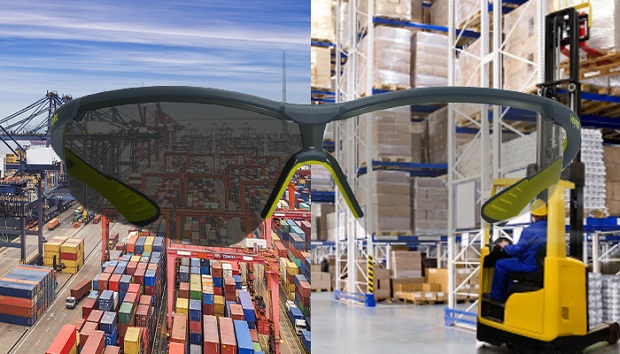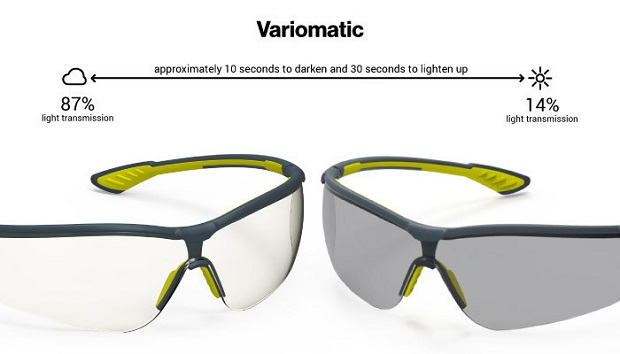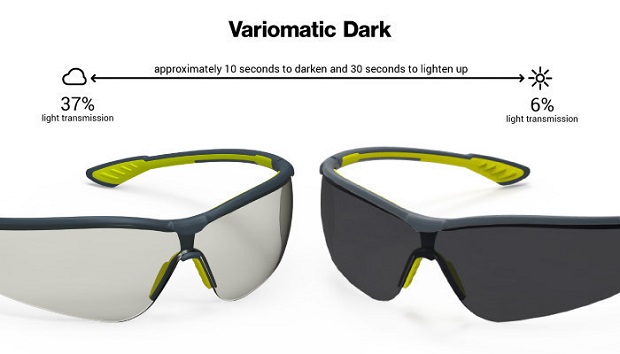HexArmor
Transition Lenses Explained

From dark to light and light to dark, transition lenses (or Variomatic lenses, as we call them at HexArmor®) work to make your life easier by automatically adapting to changing light; darkening when outdoors and returning to clear when indoors or in the shade (with no UV). Most commonly paired with prescription glasses, transition lenses are also found on safety eyewear – where they have several advantages to help keep workers safe.
There are a lot of questions surrounding this type of lens, so we want to make sure you have all the information you need to make an educated decision on the safety eyewear lenses that are right for you.
Let’s dive into the details of transition lenses for safety eyewear, starting with the most frequently asked questions.
The Questions We Get the Most
1. What are photochromic safety glasses?
Photochromic is another word for transition (or Variomatic in HexArmor® terms), and these types of lenses transition from a lighter to a darker tint with different exposures to UV light.
2. What is Variomatic?
Variomatic is HexArmor’s lens transition technology. Applied as a lacquer, Variomatic safety lenses are designed to be nearly clear when not exposed to sunlight and progressively darken when exposed to various concentrations of UV light, and come in two different styles, regular and dark (more on this later).
3. Are transition safety glasses bad for your eyes?
No, and in fact, they are the opposite. Transition safety glasses can help ease the strain on eyes as they automatically adjust to various lighting conditions, helping mitigate potential headaches, eye strain, or worse.
Additionally, the majority of safety eyewear on the market protects against 99.9% of UV rays. For more, advanced protection, all lens options in HexArmor’s safety eyewear lineup offers 100% UV protection.
4. Can you wear transition lenses while driving?
Yes, you can wear transition lenses while driving, however, if you are looking for protection from glare or brightness, you may want an alternative; most transition lenses found in safety eyewear will not work as windshields are designed to block UV rays, which causes the lenses to darken.
However, we recommend our Variomatic Dark safety lenses for these situations, as the lenses are already tinted.
5. Can transition lenses be anti-fog and scratch resistant?
Yes, you can find both of these added benefits in safety transition lenses. However, not all of these types of coatings are the same; make sure to do your research on the technology being used to find the best solution to fit your needs.
6. Can you wear transition safety glasses at night?
Yes, you can wear transition lenses at night as they will be nearly clear, and you’ll get the same safety protection against environmental debris with or without UV exposure.
We recommend our standard Variomatic lenses for this situation.
7. Are transition safety glasses worth the money?
This depends on your situation. If you are frequently going inside and outside, transition safety glasses can help keep you in compliance and mitigate eye issues – especially if you are mandated to wear safety eyewear – as you only need one pair instead of many to accommodate different light environments which keeps the eyewear on the face, leading to a reduction of injuries.
Increase Compliance and Convenience with Variomatic
HexArmor’s Variomatic lenses have some unique characteristics that help workers going between indoor and outdoor environments stay comfortable, productive, and compliant all day long.
One Pair vs. Many – With safety eyewear in particular, it’s easy for workers to forget them or not have time to go grab a new pair, but Variomatic lenses remove the need to switch between multiple pairs throughout the day or carry more than one pair – keeping more safety eyewear on more faces for longer periods of time.
Promote Eye Health – Over time, transitioning from inside to outside or working in different lighting conditions can take a toll on your eyesight or productivity, not to mention the temporary blindness that can be caused by stepping into bright sunlight, but the fast transition times with Variomatic helps lessen the strain on your eyes, allowing you to keep your vision uninhibited.
Cost Savings – In our experience, these lenses are taken care of better due to pride of ownership, which leads to better cost in use, reduction of injuries through increased longevity, and SKU reduction from the eliminated need to stock multiple tints.
Permanent Anti-Fog Coating – Standard on our Variomatic lenses is HexArmor’s signature TruShield® coating that offers permanent anti-fog and scratch resistance coatings, as well as 100% UV protection.
HexArmor® Variomatic Lens Options:
- Variomatic (regular) – 87% - 14%
- Lens progression from light to dark takes 10 seconds – from 86% light transmission to around 14% light transmission. Lens progression from dark to light takes up to 30 seconds when you go back inside.
- Works best in situations where you’re primarily indoors but go outside from time to time (or you’re working before sunrise and into daytime).

- Variomatic Dark – 37% - 6%
- Lens progression from light to dark takes 10 seconds – from 37% light transmission to around 6% light transmission as the UV light intensifies. Lens progression from dark to light takes up to 30 seconds when you go back inside.
- Works best if you’re primarily outside on the job site and working in intense sunlight most of the day, where the intensity of the light gets higher during various times.

Not Sure What You Need? HexArmor® Can Help
There are several factors to consider when choosing which lens tints or lens technology is right for you. HexArmor® offers several tints for various applications and environments. If you need help choosing the type of lens protection you need, contact one of our Solutions Specialists today at 1.877.MY.ARMOR or fill out our contact form.
Source: https://www.hexarmor.com/posts/transition-safety-glasses-lenses-explained

|